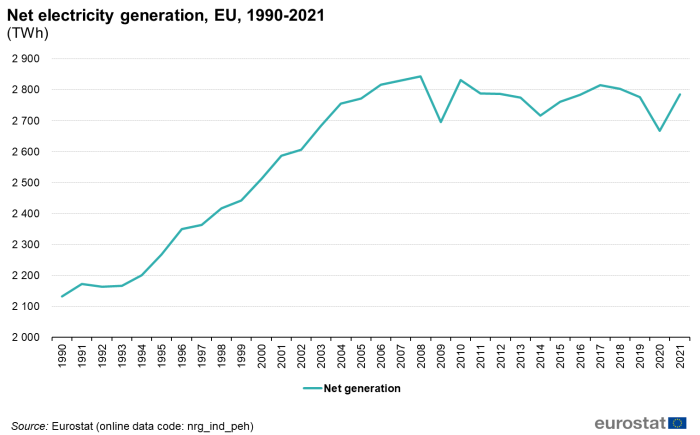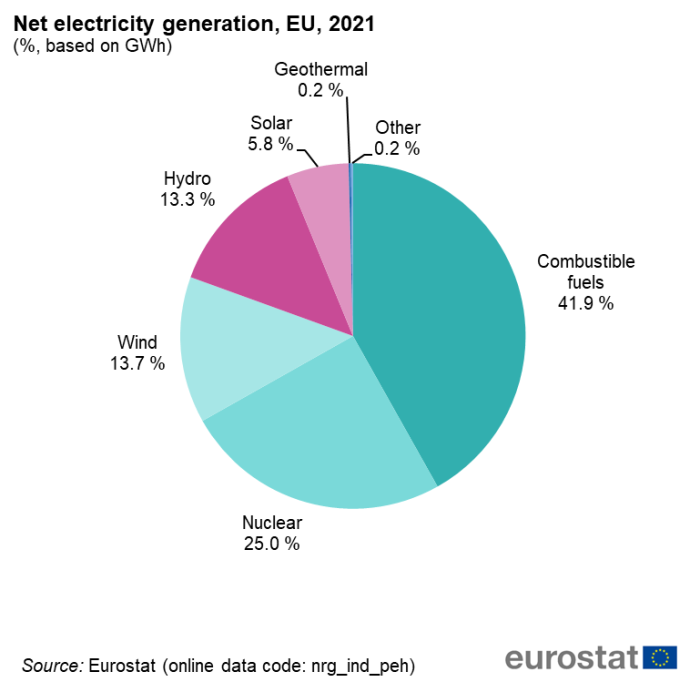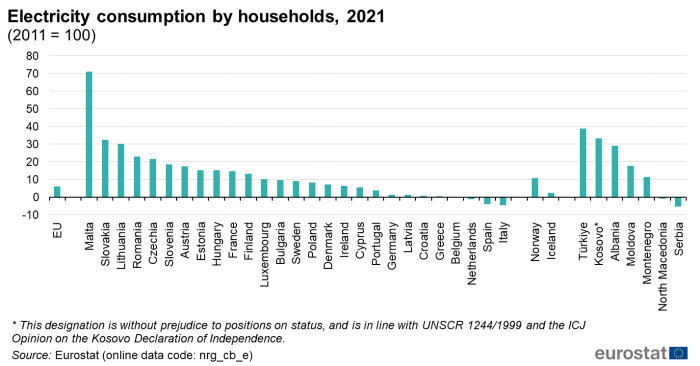Electricity production, consumption and market overview
Data extracted in February 2023.
Planned article update: June 2024.
Highlights
Total net electricity generation in the EU was 2 785 TWh in 2021, similar to 2020 (-0.1%).
Wind, hydro and solar were used to produce 32.8% of the net electricity generated in the EU in 2021.
Net electricity generation, EU, 1990-2021
This article describes the electricity market in the European Union (EU) with an analysis of electricity production/generation (the two terms are used synonymously) according to a range of different energy sources. It also provides information concerning electricity consumption by households and concludes with statistics on the level of market liberalisation (as measured by the share of the largest generator) within electricity markets.
Full article
Electricity generation
Total net electricity generation in the EU was 2 785 Terawatt hours (TWh) in 2021 — a reduction of 0.1 % compared with the year before (see Figure 1). The level of net electricity generation in the EU in 2021 was 2 % lower than its relative peak in 2008, when total output stood at 2 844 TWh.
Germany had the highest level of net electricity generation in 2021 among the EU Member States, accounting for 20.1 % of the EU total, just ahead of France (19.1 %); Italy (10.2 %) was the only other Member State with a double-digit share.
During the period covering 2011 to 2021, there was a decrease of 0.1 % in the level of EU net electricity generation (see Figure 2). The largest overall increases were registered in Croatia (34.5 %), Norway (23.8 %) and Ireland (17.7 %). Among the EU Member States where there was a lower level of electricity generation in 2021 (compared with 2011), a reduction of more than 40 % was recorded in Estonia and Luxembourg.
It should be noted that changes in electricity generation do not directly reflect changes in electricity consumption as they are also affected by electricity imports and exports.
Between 2020 and 2021, the largest annual increases in electricity generation were recorded for Estonia (21.5 %) and Greece (17 %). At the other end of the scale, the largest reductions were observed in Lithuania (-8.6 %), Slovenia (-7.6 %) and Portugal (-3.7 %).
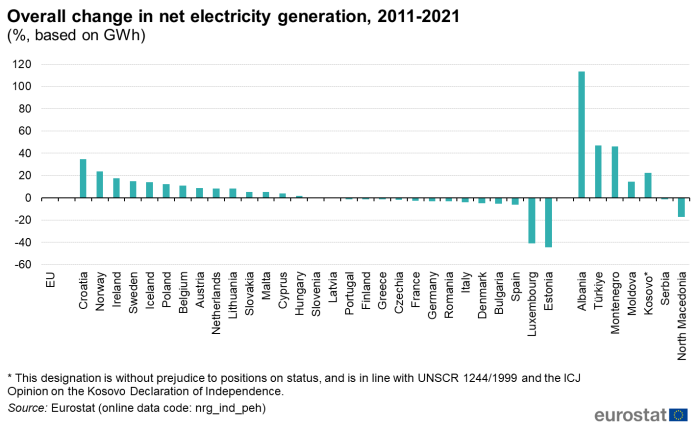
(%, based on GWh)
Source: Eurostat (nrg_ind_peh)
More than half (58.1 %) of the net electricity generated in the EU in 2021 came from non-combustible primary sources. Less than half (41.9 %) came from combustible fuels (such as natural gas, coal and oil). A quarter (25 %) came from nuclear power stations. Among the renewable energy sources shown in Figure 3, the highest share of net electricity generation in 2021 was from wind turbines (13.7 %), followed by hydropower plants (13.3 %) and solar power (5.8 %).
The relative significance of renewable energy sources in relation to EU net electricity generation grew between 2011 and 2021 from 19.5 % to 33 %, while there was a relatively large decrease in the significance of combustible fuels from 51.8 % to 41.9 % and also a reduction in the share of electricity generated from nuclear power plants from 28.5 % to 25 %. Among the renewable energy sources, the proportion of net electricity generated from solar and wind increased greatly: from 1.7 % in 2011 to 5.8 % in 2021 for solar power and from 5.8 % in 2011 to 13.7 % in 2021 for wind turbines.
Household electricity consumption
During the 10-year period from 2011 to 2021, the consumption of electricity by households increased in the EU by 6.2 % (see Figure 4). These figures on overall household electricity consumption are likely to be influenced, in part, by the average number of persons living in each household and by the total number of households, both of which are linked to demographic events. Other influences include the extent of ownership and use of electrical household appliances and consumer goods as well as the use of energy saving devices.
Electricity consumption by households rose at a much faster rate than the EU average between 2011 and 2021 in Malta (where the overall growth was 71.2 %), while an increase of 32.5 % was recorded for Slovakia and a rise of 30.3 % in Lithuania. At the other end of the scale, household electricity consumption fell in three of the EU Member States, in Italy (-4.4 %), Spain (-3.9 %) and Netherlands (-1.3 %).
One measure that is used to monitor the extent of electricity market liberalisation is the market share of the largest generator in each country (see Figure 5). Three EU Member States — Cyprus, France, Croatia — reported shares of at least 70 %. From 2016 data, Malta reported a high share, as well. The lowest shares were reported for Lithuania (16.9 %) and Italy (17 %). Especially for Poland, the reported largest electricity generator share corresponds to a unit of a larger operator.
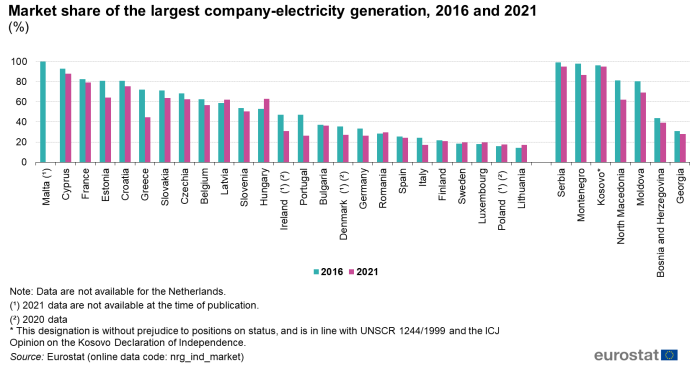
(%)
Source: Eurostat (nrg_ind_market)
An analysis of developments between 2016 and 2021 reveals that among the 25 EU Member States for which data are available (no data for Austria and the Netherlands), six saw an increase in the market share of their leading electricity generator. The most rapid developments were in Portugal and Greece where the largest generator lost at least 35 % of its own market share. The two Member States where the share of the largest generator within the electricity generation market increased the most were Hungary (19.1 %) and Belgium (18.7 %).
Source data for tables and graphs
Data sources
Electricity is produced as a primary or secondary product in power plants. The total amount of electricity produced is referred to as gross electricity production. However, power plants consume some electricity for their own use (in plant auxiliaries and in other transformers) and net electricity production is obtained by deducting this amount from gross production. Net production is distributed through national transmission and distribution grids to final consumers, transformed to heat in boilers or heat pumps, stored using pumped storage, or traded (exported or imported).
Final consumption of electricity covers the electricity delivered to the consumer's door (industry, transport, households and other sectors); it excludes deliveries for transformation and/or own use of energy producing activities, as well as network losses.
The market share of electricity generators is based on their net electricity production, and as such the electricity used by generators for their own consumption is not taken into account.
Context
In December 2019, the EU Green Deal The European Green Deal (COM(2019) 640 final) was adopted. Through the EU Green Deal, the European Commission provides an action plan to boost the efficient use of resources by moving to a clean, circular economy, restoring biodiversity and reducing pollution. The EU aims to be climate neutral in 2050. The framework for achieving climate neutrality is provided by the EU Green Deal European Climate Law (COM(2020) 80 final). Reaching this target will require action by all sectors of our economy, including investing in environmentally-friendly technologies, supporting industry to innovate, rolling out cleaner, cheaper and healthier forms of private and public transport, decarbonising the energy sector, ensuring buildings are more energy efficient and working with international partners to improve global environmental standards.
The Fit for 55 legislative proposals cover a wide range of policy areas including climate, energy, transport and taxation, setting out the ways in which the Commission will reach its updated 2030 target in real terms.
The electricity market was liberalised for small business consumers in July 2004 and for all consumers in July 2007. However, initially the opening-up of markets faced a number of shortcomings and several legal packages followed. The most relevant recent ones are:
On 1 January 2020, the Regulation (EU) No 2019/943 of 5 June 2019 on the internal market for electricity entered into force. An important part of the new electricity market design, agreed under the Clean energy for all Europeans package, the regulation establishes the fundamental principles for an efficient electricity market. In the framework of Clean energy for all Europeans package, the Directive (EU) 2019/944 of 5 June 2019 on common rules for the internal market for electricity and amending Directive 2012/27/EU was adopted. The Directive (EU) 2019/944, among others focuses on: "The internal market for electricity, which has been progressively implemented throughout the Union since 1999, aims, by organising competitive electricity markets across country borders, to deliver real choice for all Union final customers, be they citizens or businesses, new business opportunities, competitive prices, efficient investment signals and higher standards of service, and to contribute to security of supply and sustainability." A key part of the Clean energy for all Europeans package is to make the EU electricity market fit for the clean energy transition based on Regulation (EU) 2019/942 of 5 June 2019 establishing a European Union Agency for the Cooperation of Energy Regulators.
Direct access to
- Energy statistics - main indicators (t_nrg_indic)
- Energy statistics - quantities (t_nrg_quant)
- Energy statistics - prices (t_nrg_price)
- Energy statistics - quantities, annual data (nrg_quanta)
- Energy statistics - market structure indicators - natural gas and electricity (nrg_market)
- Shedding light on energy in the EU — A guided tour of energy statistics (digital publication) — 2016 edition
- Energy balance sheets — 2017 data — 2019 edition
- Energy, transport and environment statistics — 2019 edition
- Supply, transformation and consumption — commodity balances (ESMS metadata file — nrg_cb_esms)
- Energy Statistics Manual
- Directive 2019/944 of 5 June 2019 on common rules for the internal market for electricity
- Summaries of EU legislation: Internal market in electricity
- Regulation (EC) 2019/942 of 5 June 2019 establishing a European Union Agency for the Cooperation of Energy Regulators
- Summaries of EU legislation: Agency for the cooperation of national energy regulators
- Regulation (EC) No 2019/943 of 5 June 2019 on the internal market for electricity
- Summaries of EU legislation: Cross-border exchanges in electricity
